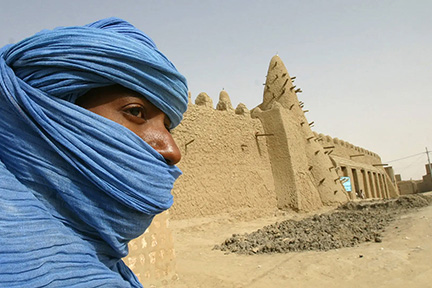
Los Tuareg del Sahara
The Tuareg of the Sahara
Historia, Cultura y Desafíos
Los Tuareg, también conocidos como los “hombres azules” debido al color índigo de sus vestimentas, son un grupo étnico nómada que habita el desierto del Sahara desde siglos, con una rica historia y cultura, que aún hoy mantienen su identidad a pesar de los desafíos políticos, sociales y económicos que enfrentaron. Sus raíces podemos hallarlas más de dos mil quinientos años en el norte de África, en los pueblos Bereberes, incluso su lengua “tamasheq”, es una rama de esas lenguas.
Utilizando camellos como medio de transporte, los Tuareg controlaron rutas comerciales cruciales que conectaban el norte con el África subsahariana, rutas vitales para el comercio de sal, oro, esclavos y otros bienes valiosos.
A pesar de haber adoptado la religión musulmana, son poseedores de una cultura profundamente rica y compleja, cuya característica es el sistema de castas, que organiza a la sociedad en distintos niveles jerárquicos, en cuya cima se encuentran los nobles, conocidos como “Imuhagh”, seguidos por los vasallos, los artesanos y los esclavos. Debemos considerar que la esclavitud fue oficialmente abolida, aún podemos observarla en algunas prácticas sociales.
Es muy importante destacar el papel prominente que las mujeres desempeñan en su sociedad que, a diferencia de muchas culturas musulmanas, las mujeres tuareg gozan de una considerable libertad y respeto, ya que pueden poseer y heredar propiedades, y su opinión es valorada en las decisiones familiares y comunitarias.
La música y la poesía son elementos centrales de la cultura tuareg, con instrumentos tradicionales como el “Imzad” (violín de una cuerda) y el “Tindé” (tambor), acompañan las canciones que relatan historias de heroísmo, amor y vida en el desierto.
La vestimenta de los Tuareg es muy distintiva, los hombres suelen llevar el “Tagelmust”, una larga tela de color índigo que envuelven alrededor de la cabeza y el rostro, protegiéndose del sol y el polvo del desierto, esta prenda no solo tiene una función práctica, sino que también simboliza la identidad y el estatus social, las mujeres, por su parte, visten ropas coloridas y adornos elaborados, reflejando su estatus y riqueza.
Siglo XXI
En la actualidad, los Tuareg enfrentan numerosos desafíos que amenazan su modo de vida tradicional, la colonización europea del norte de África en el siglo XIX y la subsecuente creación de fronteras nacionales fragmentaron el territorio tuareg, dividiéndolo entre varios países, incluyendo Malí, Níger, Argelia, Libia y Burkina Faso. Por esta razón, desde la década de 1960, las rebeliones tuareg han sido una constante en la historia reciente de la región, buscando su autonomía y mejoras en las condiciones de vida.
La más reciente comenzó en 2012, cuando el Movimiento Nacional para la Liberación del Azawad (MNLA) declaró la independencia de una vasta región del norte de Malí, que concluyó con la intervención militar de Francia contra los revolucionarios. A pesar de estos desafíos, los Tuareg han mostrado una notable resiliencia en la preservación de su cultura y tradiciones, como sus festividades y ceremonias, el festival de la Cure Salée en Níger, que son eventos comunitarios donde se celebran las tradiciones y se fortalecen los lazos sociales.
No hay dudas que mientras enfrentan los retos del siglo XXI, los Tuareg continúan siendo un símbolo de resistencia y adaptación en uno de los entornos más extremos del planeta.
The Tuareg, also known as the “blue men” due to the indigo color of their garments, are a nomadic ethnic group that has inhabited the Sahara Desert for centuries. They have a rich history and culture, and they continue to maintain their identity despite the political, social, and economic challenges they have faced. Their roots can be traced back more than 2,500 years in North Africa, to the Berber peoples. Even their language, “Tamasheq,” is a branch of those languages.
Using camels as their primary means of transportation, the Tuareg controlled crucial trade routes connecting North Africa with sub-Saharan Africa. These routes were vital for the trade of salt, gold, slaves, and other valuable goods.
Despite having adopted the Muslim religion, they possess a deeply rich and complex culture, characterized by a caste system that organizes society into different hierarchical levels. At the top are the nobles, known as “Imuhagh,” followed by vassals, artisans, and slaves. It is important to note that although slavery was officially abolished, it can still be observed in some social practices.
One notable aspect is the prominent role women play in their society. Unlike many Muslim cultures, Tuareg women enjoy considerable freedom and respect. They can own and inherit property, and their opinions are valued in family and community decisions.
Music and poetry are central elements of Tuareg culture, with traditional instruments like the “Imzad” (a one-stringed violin) and the “Tindé” (a drum) accompanying songs that tell stories of heroism, love, and life in the desert.
Tuareg attire is very distinctive. Men typically wear the “Tagelmust,” a long indigo cloth wrapped around the head and face to protect against the sun and desert dust. This garment not only serves a practical purpose but also symbolizes identity and social status. Women, on the other hand, wear colorful clothes and elaborate adornments, reflecting their status and wealth.
21st Century
Today, the Tuareg face numerous challenges that threaten their traditional way of life. The European colonization of North Africa in the 19th century and the subsequent creation of national borders fragmented Tuareg territory, dividing it among several countries, including Mali, Niger, Algeria, Libya, and Burkina Faso. Since the 1960s, Tuareg rebellions have been a constant in the recent history of the region, seeking autonomy and improved living conditions.
The most recent rebellion began in 2012 when the National Movement for the Liberation of Azawad (MNLA) declared the independence of a vast region in northern Mali. This ended with French military intervention against the revolutionaries. Despite these challenges, the Tuareg have shown remarkable resilience in preserving their culture and traditions. Their festivals and ceremonies, such as the Cure Salée festival in Niger, are community events that celebrate traditions and strengthen social bonds.
Undoubtedly, as they face the challenges of the 21st century, the Tuareg continue to be a symbol of resilience and adaptation in one of the planet’s most extreme environments.






















